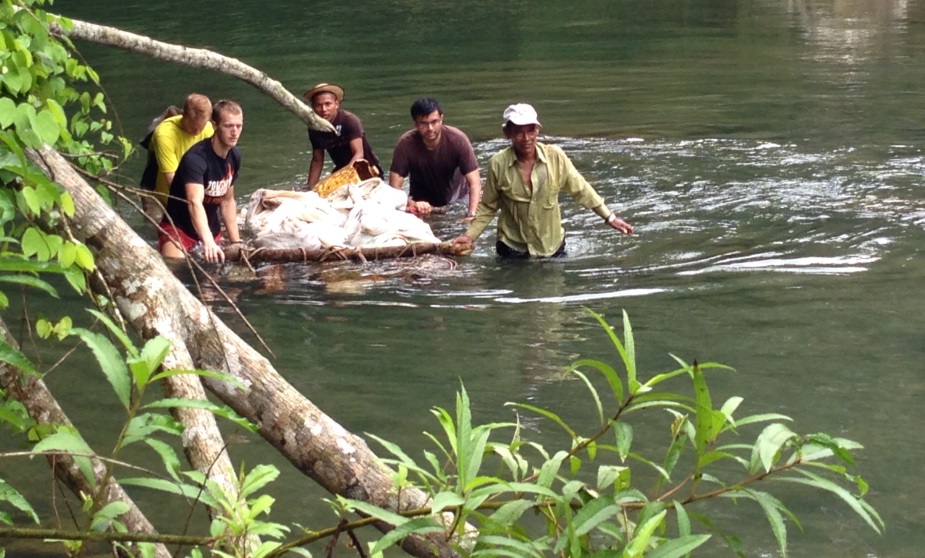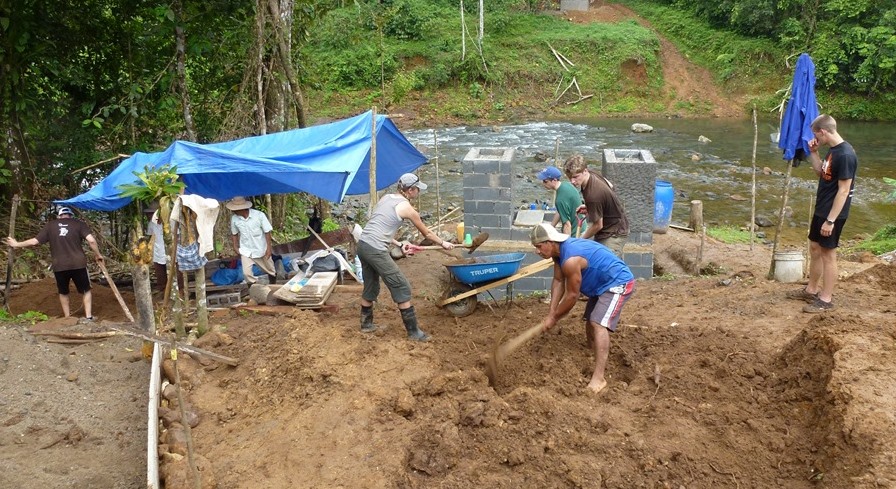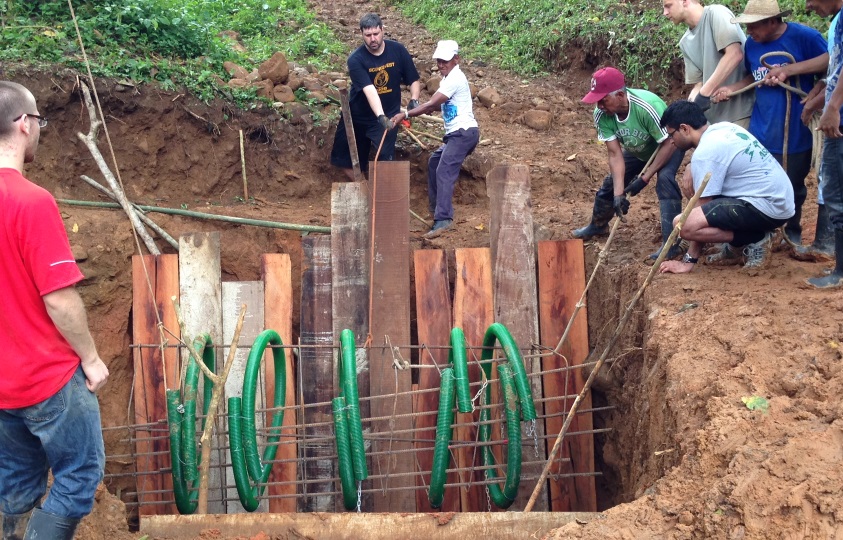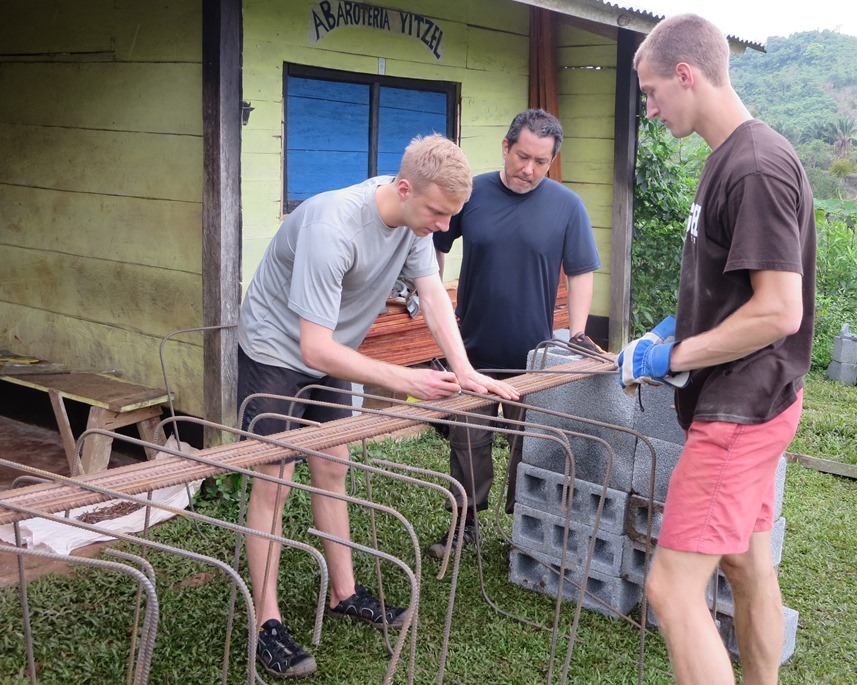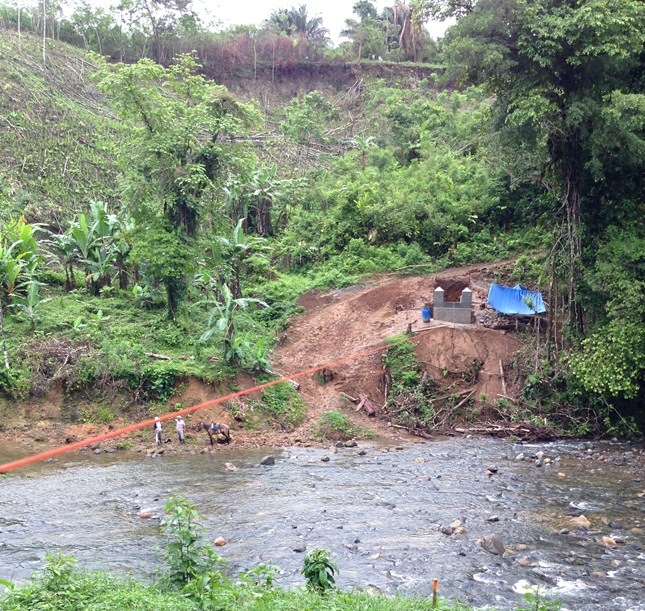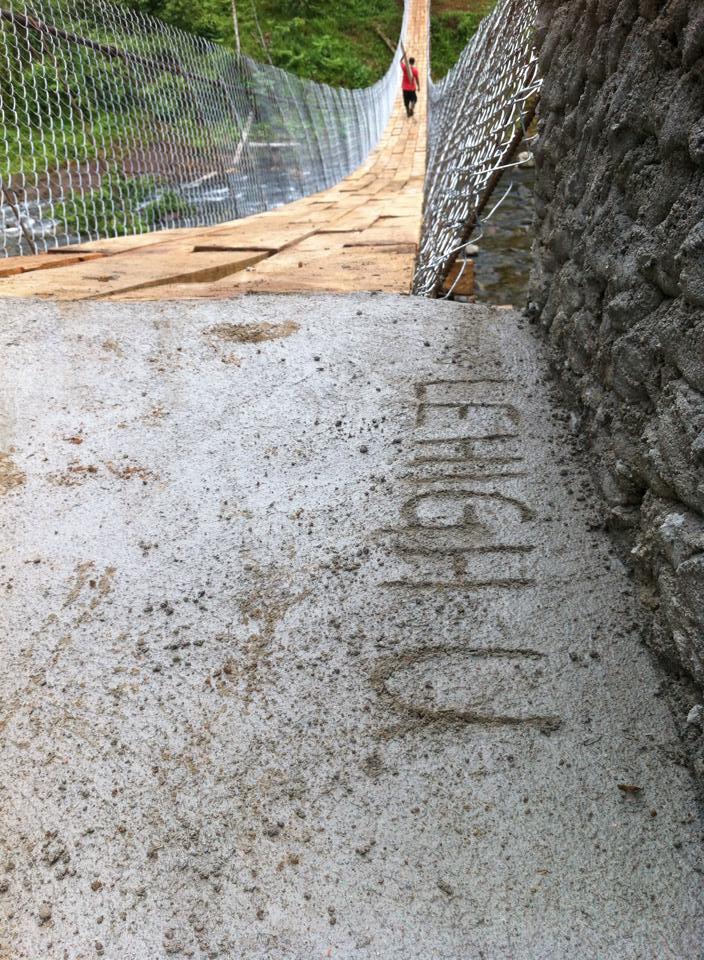Good bridges, good neighbors
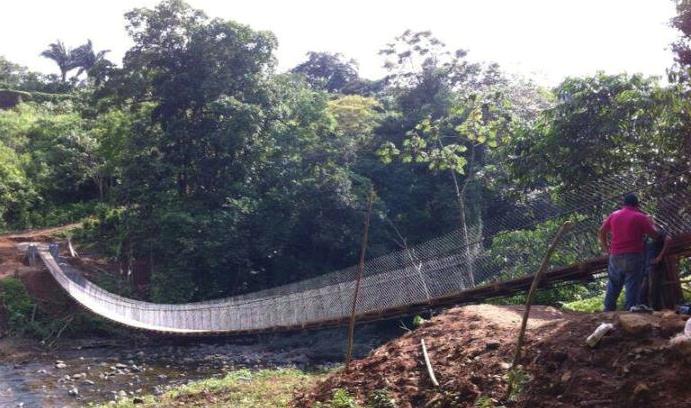
This new 243-foot bridge over Panama’s Rio Indio connects the remote villages of El Harino and Vallecito. It was built by civil engineering majors in the Lehigh student chapter of Bridges to Prosperity (B2P).
Seven students flew to Panama City, Panama, last May and boarded a bus headed southwest to the mountains in the center of the country.
One hour later, the students got into the back of a pickup truck, and continued for another hour on a dirt road.
When the pickup could go no further over the muddy, mountainous terrain, the group got out and hiked for another hour, hauling their belongings and equipment to their base of operations, the small village of El Valle along the Rio Indio river.
The students, seven civil engineering majors, were now were ready to build a bridge.
The Rio Indio divides the remote communities of El Harino and Vallecito. During the dry season in Panama, from mid-December to early May, the river runs approximately three feet deep. Still, residents cross it on foot.
When heavy rains begin in May, the Rio Indio can rise five feet in 30 minutes. Now impassable, the surging river completely cuts off residents’ access to essential resources located on the other side of the river. Children in El Harino cannot attend school. Residents of Vallecito cannot reach the paved road, shop at the market, or receive medical care. The isolation makes daily life in this already impoverished community challenging at best, devastating at worst.
A footbridge, however, changes everything.
The students who traveled to El Valle were members of the Lehigh student chapter of Bridges to Prosperity (B2P), a nonprofit organization that partners with university student chapters to build footbridges in isolated communities around the world.
A 243-foot-long capstone project
Hardik Doshi, a former B2P intern who received a master’s of engineering degree in structural engineering from Lehigh in 2013, introduced B2P to a group of undergraduate civil engineering students a little more than a year ago.
The students applied to B2P for chapter status and raised more than $20,000 for their project in Panama, receiving a Thornton Tomasetti Foundation grant and a Grant for Experiential Learning in Health from Lehigh.
In January, Russ Vignali ’14 and Juan Viteri-Yaquian ’14 traveled to Panama to survey and select a site. Equipped with the necessary information about the Rio Indio, the group began to design a suspended footbridge with a 243-foot span.
“This effort represents a capstone of everything the students learn for their civil engineering degree,” says Clay Naito, associate professor of civil and environmental engineering and the B2P chapter’s adviser. “The exciting part of the project is that they can take the designs they develop in the classroom out to the site and actually build them.”
Engineering students typically work on paper or build a replica of something already in existence, says Doshi, who assisted with the project, “but this is completely different. They get a chance to actually make a difference and at the same time use their engineering knowledge for something that’s really valuable.”
Today, the footbridge is completed and its impact on the community is immeasurable. Children no longer miss months of school. Farmers can travel to the main marketplace to sell their crops. Obtaining medical care no longer involves tremendous risk. The Lehigh B2P footbridge has changed everything.
Next year, the chapter is planning to build another bridge in Panama. Tara Hofferth ’15, who led this year’s group, says the transformative project taught her how to think innovatively.
“This experience gave me the opportunity to work with a group of students that I did not know on an unprecedented project,” Hofferth wrote in a report about the project. “[It] involved being creative and innovative, thinking from a multi-disciplinary perspective, networking, and stepping outside of my comfort zone.
“I think we’re going to be a lot more prepared to be even more successful next time.
“The Lehigh University Bridges to Prosperity Chapter is just getting started.”
One hour later, the students got into the back of a pickup truck, and continued for another hour on a dirt road.
When the pickup could go no further over the muddy, mountainous terrain, the group got out and hiked for another hour, hauling their belongings and equipment to their base of operations, the small village of El Valle along the Rio Indio river.
The students, seven civil engineering majors, were now were ready to build a bridge.
The Rio Indio divides the remote communities of El Harino and Vallecito. During the dry season in Panama, from mid-December to early May, the river runs approximately three feet deep. Still, residents cross it on foot.
When heavy rains begin in May, the Rio Indio can rise five feet in 30 minutes. Now impassable, the surging river completely cuts off residents’ access to essential resources located on the other side of the river. Children in El Harino cannot attend school. Residents of Vallecito cannot reach the paved road, shop at the market, or receive medical care. The isolation makes daily life in this already impoverished community challenging at best, devastating at worst.
A footbridge, however, changes everything.
The students who traveled to El Valle were members of the Lehigh student chapter of Bridges to Prosperity (B2P), a nonprofit organization that partners with university student chapters to build footbridges in isolated communities around the world.
A 243-foot-long capstone project
Hardik Doshi, a former B2P intern who received a master’s of engineering degree in structural engineering from Lehigh in 2013, introduced B2P to a group of undergraduate civil engineering students a little more than a year ago.
The students applied to B2P for chapter status and raised more than $20,000 for their project in Panama, receiving a Thornton Tomasetti Foundation grant and a Grant for Experiential Learning in Health from Lehigh.
In January, Russ Vignali ’14 and Juan Viteri-Yaquian ’14 traveled to Panama to survey and select a site. Equipped with the necessary information about the Rio Indio, the group began to design a suspended footbridge with a 243-foot span.
“This effort represents a capstone of everything the students learn for their civil engineering degree,” says Clay Naito, associate professor of civil and environmental engineering and the B2P chapter’s adviser. “The exciting part of the project is that they can take the designs they develop in the classroom out to the site and actually build them.”
In addition to Naito, four other advisers accompanied the students on the three-week bridge-building trip. They were Peter Bryan, systems manager for the ATLSS (Advanced Technology for Large Structural Systems) Center; Daniel Zeroka, engineering technician in the department of civil and environmental engineering; Darrick J. Fritchman, ATLSS operations manager; and Patrick Trasborg ’14 Ph.D. The Lehigh group was hosted by local families in El Valle.
Assisted by local volunteers, the group dug trenches with shovels and carried equipment and materials such as cement, rebar and 1,000-pound cables on the arduous 40-minute hike from El Valle to the bridge site in Vallecito. Hard work and creative problem solving became routine on the project.
Assisted by local volunteers, the group dug trenches with shovels and carried equipment and materials such as cement, rebar and 1,000-pound cables on the arduous 40-minute hike from El Valle to the bridge site in Vallecito. Hard work and creative problem solving became routine on the project.
Engineering students typically work on paper or build a replica of something already in existence, says Doshi, who assisted with the project, “but this is completely different. They get a chance to actually make a difference and at the same time use their engineering knowledge for something that’s really valuable.”
Today, the footbridge is completed and its impact on the community is immeasurable. Children no longer miss months of school. Farmers can travel to the main marketplace to sell their crops. Obtaining medical care no longer involves tremendous risk. The Lehigh B2P footbridge has changed everything.
Next year, the chapter is planning to build another bridge in Panama. Tara Hofferth ’15, who led this year’s group, says the transformative project taught her how to think innovatively.
“This experience gave me the opportunity to work with a group of students that I did not know on an unprecedented project,” Hofferth wrote in a report about the project. “[It] involved being creative and innovative, thinking from a multi-disciplinary perspective, networking, and stepping outside of my comfort zone.
“I think we’re going to be a lot more prepared to be even more successful next time.
“The Lehigh University Bridges to Prosperity Chapter is just getting started.”
Posted on:
Tuesday, September 16, 2014


